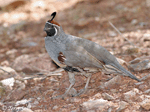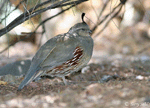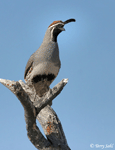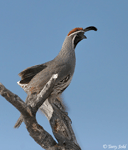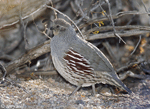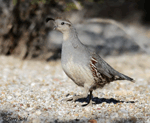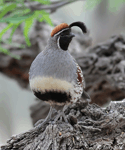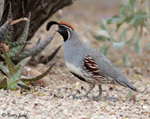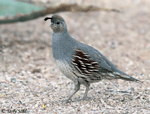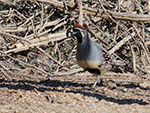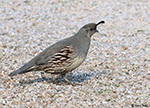| Length: 10 inches | Wingspan: 14 inches | Seasonality: Non-resident in South Dakota |
| ID Keys: Curved topknot, black chin and face, grayish upperparts and breast, unmarked belly | ||
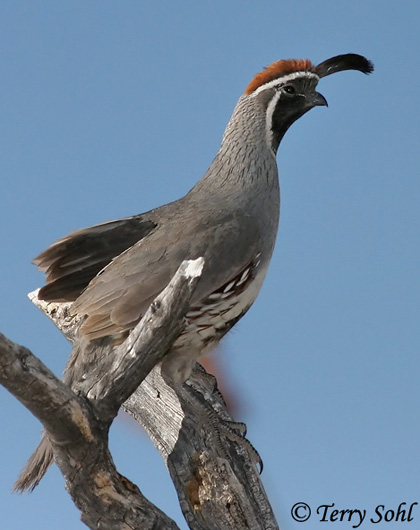 Gambel's Quail are the Sonoran desert equivalent of the closely related
California Quail. The ranges
of the two species do not overlap, but the plumages are quite similar, right
down to the distinctive curved "topknot" feather (actually a plume of 6
individual feathers). Gambel's Quail inhabitat the dry shrubby
habitats of the desert Southwest, where small coveys of the birds can often
be seen scurrying across roads or through desert vegetation. The
handsome birds have been introduced on some of the Hawaiin Islands.
Gambel's Quail are the Sonoran desert equivalent of the closely related
California Quail. The ranges
of the two species do not overlap, but the plumages are quite similar, right
down to the distinctive curved "topknot" feather (actually a plume of 6
individual feathers). Gambel's Quail inhabitat the dry shrubby
habitats of the desert Southwest, where small coveys of the birds can often
be seen scurrying across roads or through desert vegetation. The
handsome birds have been introduced on some of the Hawaiin Islands.
Habitat: They have adapted very well to dry Sonoran desert environments, but the largest concentrations of Gambel's Quail are often found around riparian areas and sources of water. They can be found in different shrubby habitats, but seem to prefer true Sonoran desert habitat with scattered cactus and mesquite. They also have adapted to living in and around suburban areas, given that adequate vegetative cover is available.
Diet: Feeds mostly on vegetative material, includings seeds, fruits, nuts, leaves, and berries. They will occasionally eat insects, but typically not as much as California Quail.
Behavior: Gambel's Quail most often forage on the ground, but will also forage in shrubs and trees. They forage in coveys outside of the breeding season with coveys of 20-30 birds a typical size, but they may forage in pairs or smaller family groups after the young have fledged in the late spring. When disturbed, they prefer to quickly run into thick cover, only taking flight when absolutely necessary to avoid danger.
Nesting: The nest is a shallow depression lined with grasses and leaves, usually placed nest to the base of a shrub or other vegetation. Females alone incubate a nest of around a dozen eggs, but both parents will help to raise the young.
Song: The male sings a repetitive, pop-ehhhhh-pop song. The species also has a variety of additional calls.
Migration: Considered a permanent resident throughout its range.
Interactive eBird Map: Click here to access an interactive eBird map of Gambel's Quail sightings
Similar Species: California Quail most similar. Also similar to Mountain Quail.
Feeders: Gambel's Quail will attend ground feeders for seed, or areas where seed is scattered on the ground.
Conservation Status: Populations of Gambel's Quail are generally stable, and the species is considered to be of "least concern" by the IUCN. Local populations may fluctuate depending upon short-term climate and foraging opportunities, but overall populations are stable.
Further Information:
Photo Information: May 10th, 2008 - Saguaro National Park, Arizona - Terry Sohl
Additional Photos: Additional, higher-resolution Gambel's Quail photos can be found at the bottom of the page.
| Click below for a higher-resolution map |
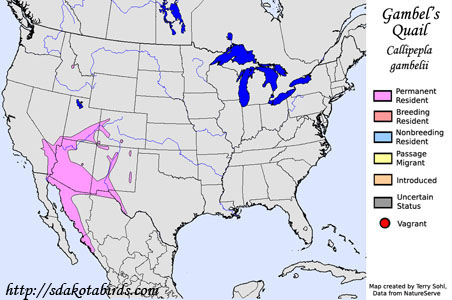 |
| South Dakota Status: Non-resident in South Dakota |
Additional Gambel's Quail Photos
Click for a higher-resolution version of these photos
